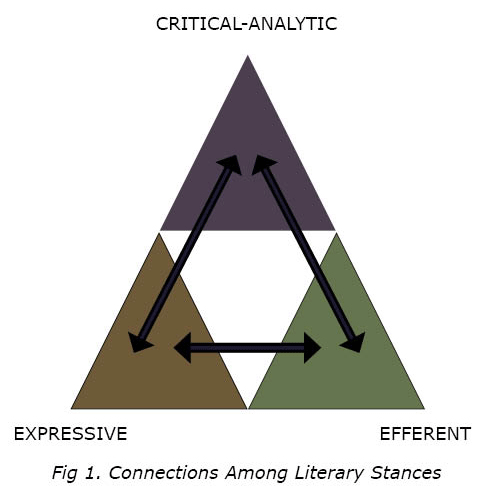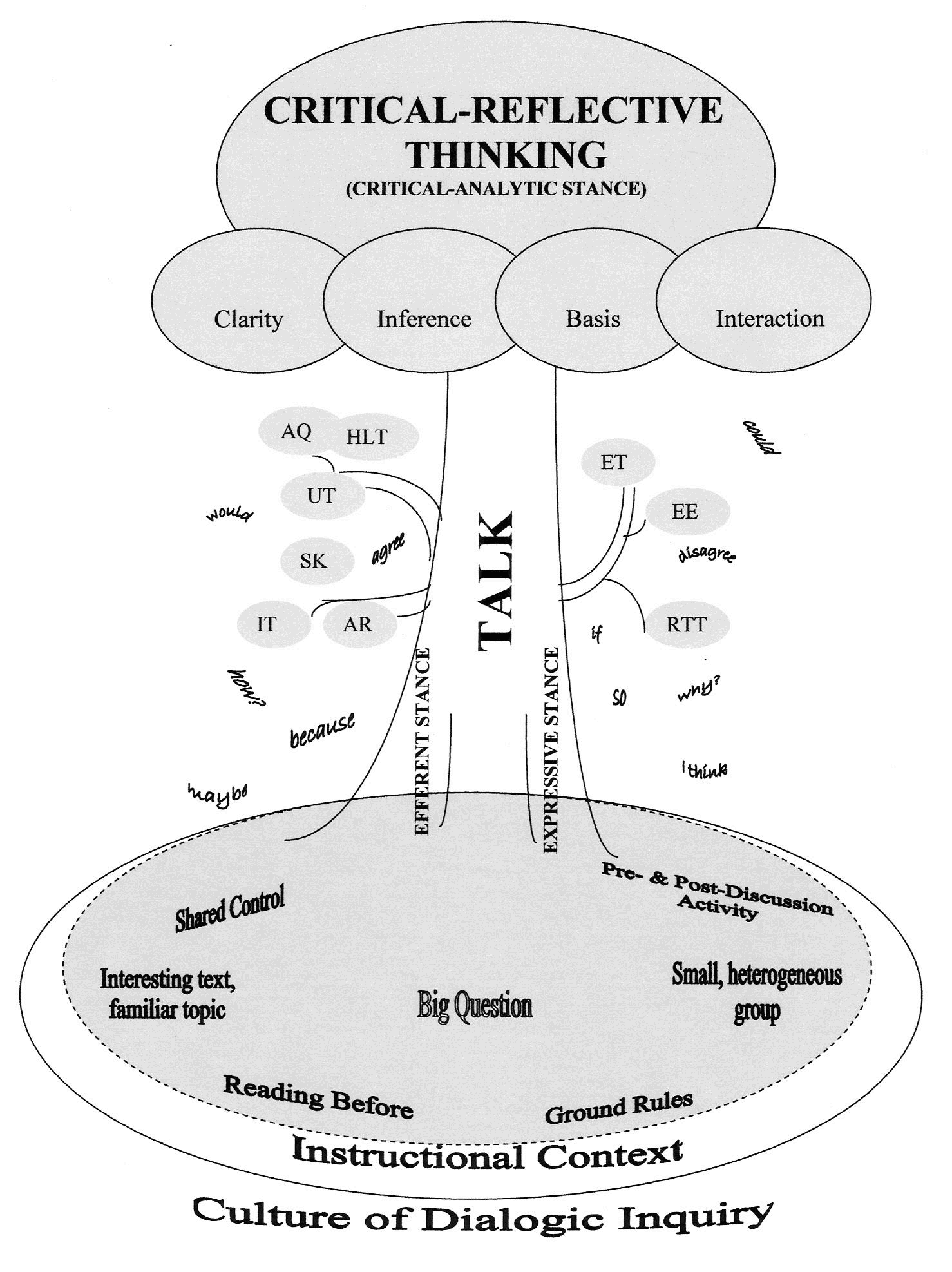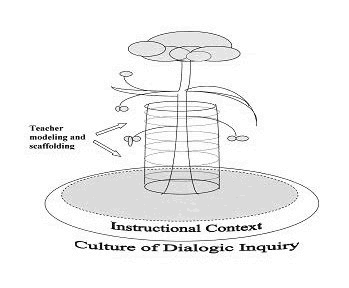
Quality Talk in depth
The goal of Quality Talk is to promote high-level comprehension of text. It is premised on the beliefs that talk is a tool for thinking, and that a certain kind of talk can contribute to critical-reflective thinking and high-level comprehension of text. Following Ennis (1987), we define critical-reflective thinking as “reasonable reflective thinking that is focused on deciding what to believe or do” (p. 10). Attributes of critical-reflective thinking are: clarity—being clear about what is being said; inference—making deductive and inductive inferences and value judgments; basis—having a reasonable basis for those inferences; and interaction—engaging in cooperative interaction with peers (Ennis, 1987). Rather than impose a highly prescriptive routine on teachers, we provide teachers with a general model that teachers can instantiate depending on their needs and the contexts in which they work. Our model comprises 4 elements:
- instructional frame;
- discourse tools and signs;
- teacher modeling and scaffolding;
- pedagogical principles
The instructional frame represents a set of parameters that we consider important for promoting quality talk about text. Table 1 shows these parameters. An important feature of productive discussions is having shared control between teacher and students, where the teacher has control over choice of text and topic, but students have interpretive authority and control of turns (i.e., an open participation structure). Another important feature is fostering a moderate to high degree of emphasis on the expressive and efferent stances toward the text. We have found that a moderate degree of affective and knowledge-driven engagement is necessary, though not sufficient, for students to interrogate or query text in search of its underlying arguments, assumptions, or beliefs. Students need to be encouraged to make spontaneous, emotive connections to the textual experience (i.e., a personal, expressive response) while reading to acquire and retrieve information (i.e., an efferent stance). Through such a connection with the text coupled with a general understanding of it, students are then well positioned to adopt a critical-analytic stance toward the text. Figure 1 illustrates our understanding of the connections among the three stances.
| Teacher | Students | Text(s) | Stance | Format | Activities |
|---|---|---|---|---|---|
| Chooses text and controls topic | Hold interpretive authority and controls turns | Read before discussion | Expressive: Med-High Efferent: Med-High Critical analytic: High |
Small heterogeneous ability groups; Teacher / peer-led but teacher-led initially | Before and after discussion to promote process and content knowledge |

The figure, Connections Among Literary Stances, is available here as a PDF
The discourse tools and signs, the second component of the model, are discursive elements teachers use to promote and to recognize productive talk about text. Foremost among these are epistemological tools teachers use to give students greater control over the flow of information: asking authentic questions that invite a range of responses, employing uptake to build on students’ contributions, and asking questions to elicit high-level thinking (generalization, analysis, and speculation) (Nystrand, Gamoran, Kachur, & Prendergast, 1997; Nystrand, Wu, Gamoran, Zeiser, & Long, 2003). These discursive elements also include questions to elicit extra-textual connections (affective, intertextual, and shared knowledge) (Applebee, Langer, Nystrand, & Gamoran, 2003; Bloome & Egan-Robertson, 1993; Edwards & Mercer, 1987; Shuart-Faris & Bloome, 2004; Taylor, Pearson, Peterson, & Roderiguez, 2003). The elements also include indicators of individual and collective reasoning: students giving elaborated explanations (Chinn, O’Donnell, & Jinks, 2000; Webb, 1989), engaging in exploratory talk (Mercer, 1995, 2000), and using key words that signal reasoning (Wegerif & Mercer, 1997; Wegerif, Mercer & Dawes, 1999). Following Vygotsky (1978), we refer to these elements as ‘tools’ and ‘signs’ to emphasize that some act as external agents to promote productive talk and some serve as internal signs of students’ high-level thinking and comprehension. Over time, this distinction becomes blurred as students internalize ways of talking about text and use these ways to support their own thinking and that of their peers.
Teacher modeling and scaffolding, the third component of the model, are conversational moves teachers employ to initiate students into productive talk about text. We have found, as have others (P. David Pearson, personal communication, April 30, 2005), that teachers need to provide temporary support in the early stages of conducting discussions to initiate students into the kind of talk that promotes critical-reflective thinking. There are no generic moves that apply to all texts and topics, as they are contingent on the momentary ebb and flow of discussion. Among potential moves are: summarizing, modeling, prompting, marking, and challenging.
The pedagogical principles, the fourth component of the model, comprise understandings about language and pedagogy that we consider essential to fostering a culture of dialogic inquiry in the classroom. These principles include basic notions about conducting discussions about text: 1) using rich, interesting texts that permit a variety of interpretations, opinions, or positions and about which students have some background knowledge; 2) collaboratively establishing norms or ground rules for discussions; and 3) initiating discussion by asking a ‘big question’—a question of central importance to understanding the text that has no known answer, and about which students’ opinions may differ. The principles also include larger ideas about language and pedagogy: 4) conceptualizing language as a tool for thinking (Mercer, 1995, 2000); 5) maintaining a clear structure and focus in a discussion yet being responsive to students’ contributions to enable generative learning (cf. Cohen, 1994; King, 1999; Salomon & Globerson, 1989); and, 6) gradually releasing responsibility for control of the discussion from teacher to students (cf. Pearson & Gallagher, 1983). The ultimate goal is for students to take responsibility for co-constructing their own interpretations of and responses to text, to reason, and to think together—a process Mercer (2002) calls ‘interthinking.’
The relationships among these four elements are shown in Figure 2. We use a tree metaphor to convey the organic nature of discussions when working with teachers. Discussions are best conducted within a classroom culture of dialogic inquiry that supports the beliefs inherent in our pedagogical principles. Without this culture, it is difficult to foster the features of the instructional context and the kinds of talk necessary for productive discussions. Note the dotted line between the classroom culture and the instructional context—culture supports the instructional context, and the instructional context helps nurture the classroom culture. Talk is fostered within the culture and instructional context and it, in turn, contributes to critical-reflective thinking about and around text. Critical-reflective thinking does not derive from just any kind of talk but from ‘Quality Talk’ characterized by features of discourse tools and signs that are linked to high-level comprehension: authentic questions, uptake, questions that promote affective response, intertextual connections, and connections to shared knowledge, elaborated explanations, exploratory talk, and reasoning words.

Figure 2. Quality Talk model (AQ = authentic questions, HLT = high-level thinking questions, UT = uptake, SK = shared-knowledge questions, IT = intertextuality questions, AR = affective response questions, ET = exploratory talk, EE = elaborated explanations, RTT = reference to text)
Not shown in Figure 2 are the modeling and scaffolding moves that teachers can use to initiate students into the kind of talk that promotes critical-reflective thinking. Modeling and scaffolding moves provide temporary support to guide growth of Quality Talk (see Figure 3).

Figure 3. Teacher modeling and scaffolding as supports for growth of Quality Talk